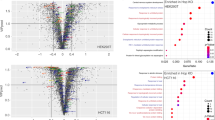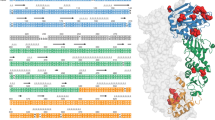Abstract
THERE is evidence to suggest that components of archaebacteria are evolutionarily related to cognates in the eukaryotic cytosol–7. We postulated that the major heat-shock protein of the thermophilic archaebacterium, Sulfolobus shibatae, is a molecular chaperone and that it is related to an as-yet unidentified chaperone component in the eukaryotic cytosol. Acquired thermotolerance in S. shibatae correlates with the predominant synthesis of this already abundant protein, referred to as thermophilic factor 55 (TF55; ref. 8). TF55 is a homo-oligomeric complex of two stacked 9-membered rings, closely resembling the 7-membered-ring complexes of the chaperonins, groEL, hsp60 and Rubisco-binding protein9–15. The TF55 complex binds unfolded polypeptides in vitro and has ATPase activity—features consistent with its being a molecular chaperone16,17. The primary structure of TF55, however, is not significantly related to the chaperonins. On the other hand, it is highly homologous (36–40% identity) to a ubiquitous eukaryotic protein, t-complex polypeptide-1 (TCP1; refs 18–20). In Saccharomyces cerevisiae, TCP1 is an essential protein that may play a part in mitotic spindle formation21. We suggest that TF55 in archaebacteria and TCP1 in the eukaryotic cytosol are members of a new class of molecular chaperones.
This is a preview of subscription content, access via your institution
Access options
Subscribe to this journal
Receive 51 print issues and online access
$199.00 per year
only $3.90 per issue
Buy this article
- Purchase on Springer Link
- Instant access to full article PDF
Prices may be subject to local taxes which are calculated during checkout
Similar content being viewed by others
References
Cavalier-Smith, T. Ann. N. Y. Acad. Sci. 503, 17–54 (1987).
Lechner, K. & Böck, A. Molec. gen. Genet. 208, 523–528 (1987).
Zillig, W. Ann. N. Y. Acad. Sci. 503, 78–82 (1987).
Dahlmann, B. et al. FEBS Lett. 251, 125–131 (1989).
Iwabe, N., Kuma, K.-I., Hasegawa, M., Osawa, S. & Miyata, T. Proc. natn. Acad. Sci. U.S.A. 86, 9355–9359 (1989).
Zillig, W. et al. Endocytobiol. Cell Res. 6, 1–25 (1989).
Auer, J., Lechner, K. & Böck, A. Can. J. Microbiol. 35, 200–204 (1989).
Trent, J. D., Osipiuk, J. & Pinkau, T. J. Bact. 172, 1478–1484 (1990).
Hendrix, R. W. J. molec. Biol. 129, 359–373 (1979).
McMullen, T. W. & Hallberg, R. L. Molec. Cell. Biol. 8, 371–380 (1988).
Pushkin, A. V. et al. Biochim. biophys. Acta 704, 379–384 (1982).
Hemmingsen, S. M. et al. Nature 333, 330–334 (1988).
Goloubinoff, P., Christeller, J. T., Gatenby, A. A. & Lorimer, G. H. Nature 342, 884–889 (1989).
Cheng, M. Y. et al. Nature 337, 620–625 (1989).
Carazo, J. M. et al. J. struct. Biol. 106, 211–220 (1991).
Rothman, J. E. Cell 59, 591–601 (1989).
Ellis, R. J. & van der Vies, S. M. A. Rev. Biochem. 60, 327–347 (1991).
Silver, L. M., Artzt, K. & Bennett, D. Cell 17, 275–284 (1979).
Silver, L. M., Kleene, K. C., Distel, R. J. & Hecht, N. B. Devl Biol. 119, 605–608 (1987).
Willison, K. R., Dudley, D. & Potter, J. Cell 44, 727–738 (1986).
Ursic, D. & Culbertson, M. R. Molec. Cell. Biol. 11, 2629–2640 (1991).
Barraclough, R. & Ellis, R. J. Biochem. biophys. Acta 608, 19–31 (1980).
Musgrove, J. E., Johnson, R. A. & Ellis, R. J. Eur. J. Biochem. 163, 529–534 (1987).
Ostermann, J., Horwich, A. L., Neupert, W. & Hartl, F.-U. Nature 341, 125–130 (1989).
Martin, J. et al. Nature 352, 36–42 (1991).
Phipps, B. M., Hoffmann, A., Stetter, K. O. & Baumeister, W. EMBO J. 10, 1711–1722 (1991).
Pfanner, N., Tropschug, M. & Neupert, W. Cell 49, 815–823 (1987).
Pelham, H. R. B. EMBO J. 8, 3171–3176 (1989).
Hendrix, R. W. J. molec. Biol. 129, 375–392 (1979).
Willison, K. et al. EMBO J. 6, 1967–1974 (1987).
Ursic, D. & Ganetzky B. Gene 68, 267–274 (1988).
Willison, K. et al. Cell 57, 621–632 (1989).
Ahmad, S. & Gupta, R. S. Biochim. biophys. Acta 1087, 253–255 (1990).
Ellis, J. R. Science 250, 954–959 (1990).
Chandrasekhar, G. N., Tilly, K., Woolford, C., Hendrix, R. & Georgopoulos, C. J. biol. Chem. 261, 12414–12419 (1986).
Searcy, D. G. & Hixon, W. G. BioSystems 25, 1–11 (1991).
Dayhoff, M. O., Schwartz, R. M. & Orcutt, B. C. in Atlas of Protein Sequencing and Structure, Vol 5, suppl. 3 (ed. Dayhoff, M. O.), 345–362 (Natn. Biomed. Res. Fdn, Washington, DC, 1979).
Shinnick, T. J. Bact. 169, 1080–1088 (1987).
Viitanen, P. V. et al. Biochemistry 29, 5665–5671 (1990).
Wall, J. S. & Hainfeld J. F. A. Rev. Biophys. biophys. Chem. 15, 355–376 (1986).
Horwich, A., Koop, A. H. & Eckhart, W. J. Virol. 36, 125–132 (1980).
Lill, R., Dowhan, W. & Wickner, W. Cell 60, 271–280 (1990).
Reiter, W.-D., Hüdepohl, U. & Zillig, W. Proc. natn. Acad. Sci. U.S.A. 87, 9509–9513 (1990).
Author information
Authors and Affiliations
Rights and permissions
About this article
Cite this article
Trent, J., Nimmesgern, E., Wall, J. et al. A molecular chaperone from a thermophilic archaebacterium is related to the eukaryotic protein t-complex polypeptide-1. Nature 354, 490–493 (1991). https://doi.org/10.1038/354490a0
Received:
Accepted:
Issue Date:
DOI: https://doi.org/10.1038/354490a0
This article is cited by
-
Stress response physiology of thermophiles
Archives of Microbiology (2017)
-
A ‘universal’ type II chaperonin PCR detection system for the investigation of Archaea in complex microbial communities
The ISME Journal (2012)
Comments
By submitting a comment you agree to abide by our Terms and Community Guidelines. If you find something abusive or that does not comply with our terms or guidelines please flag it as inappropriate.



